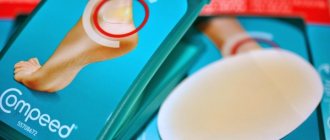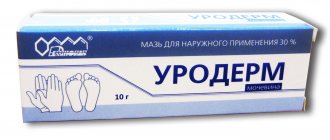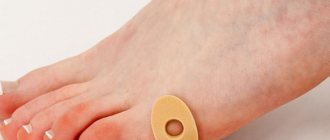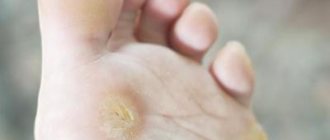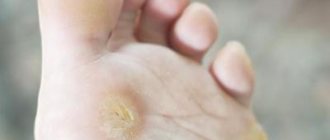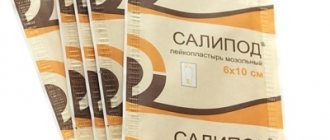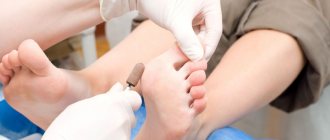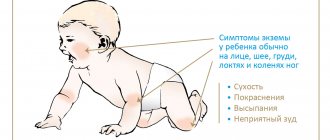The article was prepared by a specialist for informational purposes only. We urge you not to self-medicate. When the first symptoms appear, consult a doctor.
A callus is a damaged area of the dermis. A callus appears due to prolonged friction of the skin or excessive pressure on the same area. On the lower extremities, calluses most often form due to the fact that a person wore uncomfortable or ill-fitting shoes. Where the pressure was maximum, a callus forms. Calluses can be dry or wet. In the latter case, a certain area of skin peels off, and the gap between it and the leg is filled with a clear liquid.
What types of calluses can there be?
Calluses can be of the following types:
- Dry callus.
It is also called a hard callus. It can be shaped like a circle or an oval; the skin on it dies, so this callus is often yellow in color. If the callus is shallow, then it will not cause physical discomfort to the person. Such skin growths are purely a cosmetic defect. If the dry callus is large and deep, it can cause pain while walking.
- Wet callus.
In this case, the skin peels off with the formation of a bubble. It will be filled with lymph. It is a clear liquid that contains blood cells that perform a protective function. If the bubble bursts, the resulting gap can become an entry point for infection. You should not deliberately open wet calluses; you need to wait until they go away on their own.
- Dry callus.
Such a callus is a growth of keratinized skin cells, in the center of which there is a rod. It goes deep into the sole. If you do not get rid of the core, the callus will appear again and again. Therefore, treatment of such growths must be targeted. Often dry calluses are combined with various infectious processes, for example, a fungal infection.
Calluses most often form on the lower extremities. You can get rid of them with a patch. There are several types of patches. They all have different shapes and are also impregnated with different medicinal compounds.
Plasters for core calluses
For core calluses, the choice is usually the Salipod patch.
It contains salicylic acid, precipitated sulfur, lanolin and natural rubber.
A fragment is manually cut out of the patch, the shape and diameter corresponding to the callus core.
It is applied to it and secured on top with an adhesive plaster for 48 hours.
If there is no effect, Salipod is reused.
This patch is very effective, but has a number of contraindications.
These are pregnancy, early childhood, allergic reactions, open wounds and moles at the site of callus formation, elderly and senile age, diabetes mellitus.
Care must be taken not to allow the Salipod patch to attach to healthy skin: burns are possible.
Compeed and Cosmos patches are used for ingrown calluses.
They are made using hydrocolloid “second skin” technology, which prevents infection after removal of the rod.
Contraindications and possible harm
Before applying the callus patch, be sure to study its composition and the attached instructions. The components of the impregnation can cause an allergic reaction, so not everyone can use them.
Contraindications for patches with keratolytic properties, in addition to individual intolerance, are:
- childhood;
- violation of skin integrity;
- dermatological diseases;
- damage to the skin of the foot as a result of diabetes.
The safest to use are silicone patches and pads. They can be used by everyone without restrictions, since they have no contraindications and do not have negative side effects.
How to choose the right patch
Security stickers are usually classified according to several criteria. The main parameter is the possibility of their use for the treatment of dry and wet calluses. The provision of a therapeutic or protective effect is then taken into account.
All types of patches must be used in accordance with the nature of the damage, so before purchasing you need to carefully study the instructions for use of the product.
Means for protection
Most often, silicone stickers are used to prevent the formation of calluses, but in some cases this problem is solved by using simple adhesive tapes in the form of adhesive tape. Such products, when attached to the skin, create a protective barrier between it and the shoes, protecting against pressure and chafing.
Silicone patches are transparent and equipped with a high-quality adhesive layer, which allows you to attach them to different parts of the foot. Such stickers prevent the appearance of dry and wet calluses. Their shape can be very diverse and depends on the configuration of the attachment site. There are also silicone pads that are placed under the heel or in the side of the shoe. There they create a shock-absorbing effect, which prevents the occurrence of corns.
Compeed patch
Represents silicone stickers of different shapes. With their help, you can prevent any growths or reduce pain from existing ones. For prevention, Compid should be placed in the area where pressure is felt most, or placed under the foot to minimize chafing when the heel of the shoe is uncomfortable.
There are other types of patches of this brand. They differ not only in shape, but also in the quality of the material and therapeutic effect. You can purchase such products at any pharmacy.
For the treatment of dry and core calluses
If it was not possible to prevent the occurrence of dry callus, it must be treated with a product that contains salicylic acid. Dry tumors with a core are especially difficult to remove. Such calluses do not cause any discomfort at an early stage. As the tubercle matures, it begins to grow into the epidermis and becomes painful.
To eliminate the problem, it is necessary to stick the solipod patch as follows:
- Before using it, feet should be steamed in hot soapy water and wiped dry. Additionally, you can treat the skin with a disinfectant spray.
- Then apply a salicylic acid sticker to the area of the callus or corn.
- You need to leave the patch on for several days until the stratum corneum softens. If necessary, it should be changed.
When the seal becomes soft, it can be removed. In this case, ingrown calluses can come off along with the rod. If this does not happen, you should remove the residue with nail scissors, having previously disinfected them.
Leiko patch
The product has an antiseptic effect. Additionally, it allows you to soften the stratum corneum. The patch is made of cotton fabric with an adhesive layer. A special washer containing salicylic acid is attached to the center, which gradually penetrates into the keratinized area and softens it.
Thanks to the design features of the Leiko patch, air is supplied to healthy skin. The damaged areas are affected by the acid, while they are protected from moisture penetration.
Urgo patch
A powerful product recommended for removing old core and common dry growths. The main active ingredient in this patch is salicylic acid.
A special feature of this product is the presence of a foam pad. Thanks to it, healthy skin does not come into contact with the active substance of the impregnation. According to customer reviews, it is most convenient to apply this patch in the evening before going to bed. The procedure must be repeated at least 3 times to remove old formations.
Products for the treatment of wet calluses
The cause of such skin damage is most often uncomfortable or poorly worn shoes. Constant friction causes the thin skin to swell and form a bubble with liquid. Wet calluses can form anywhere on the foot where friction occurs, even between the toes. When the tumor is opened, severe burning and pain occur. The danger lies in the fact that infection easily penetrates into an open wound.
To cure a wet callus, the patch should have the following effects:
- protect the damaged surface from infection;
- eliminate pain and discomfort;
- protect from further damage;
- promote healing;
- prevent moisture from entering.
In this case, it is recommended to use liquid patches or stickers made of hydrocolloid material. The products are applied to the pre-disinfected foot, taking care not to damage the bladder and prevent dirt and moisture from entering.
Adhesive bandage Cosmos
Cosmos is one of the few products that have a hypoallergenic effect. This patch is made of elastic silicone material that prevents dirt and moisture from entering the damaged area. With this remedy you can relieve pain and speed up the restoration of the epidermis.
Before use, the skin must be washed and disinfected. The patch must then be glued so that the hydrocolloid pad is positioned over the callus. You need to wear the protective sticker for 2 days. Usually this time is enough for the damage to heal.
Liquid patch Akutol
This unique product is available in gel form. When applied, a thin stretchable film is formed on the skin, which protects the callus from contamination and damage.
This patch contains:
- collodion;
- rosin;
- acrylates;
- ethylcellulose;
- natural vegetable oils.
This coating has a thin, durable structure. At the same time, the film allows the skin to breathe. The product easily lasts up to 10 hours without damage.
Remedies for corns
Since such neoplasms are large in size, products for their removal must have a large surface area with the active substance. Typically, anti-corns patches are a piece of fabric with an adhesive surface, impregnated with the active substance over the entire area. The impregnation of such a product is made from vegetable oils, salicylic acid and other useful components.
Such patches must be warmed before use by holding them a little in your palms.
Before using the remedy for corns, you should steam the skin of your feet in a hot soapy solution, wipe dry and stick the adhesive side with the active substance to the skin. You need to wear the callus patch for as long as indicated in the instructions on the package. If necessary, you can replace it. After removing the protective sticker, the softened skin should be removed with a pumice stone, washed and applied with moisturizer.
Salipod
This inexpensive remedy allows you to quickly remove corns. The active substance in Salipoda is a mixture of salicylic acid and sulfur. The components in this combination disinfect the damaged surface, kill germs and accelerate healing.
After dissolving and softening the rough areas, the patch stimulates regeneration and helps restore the skin. Salipod should not be used in childhood or if there is an allergic reaction to its components.
Long-term use of the protective sticker causes side effects such as burning, itching, redness of the epidermis and a feeling of discomfort.
Patches for soft (wet) calluses
The patch is aimed at preventing wound infection, protecting damaged skin, resolving blisters and relieving pain.
Such patches are made from hydrocolloid materials that act like a “second skin.”
It is strictly contraindicated to open the blisters on your own.
This leads to infection and, upon healing, to disfigurement of the skin area.
If the bubble has opened, the skin around the wound is treated with hydrogen peroxide or furatsilin solution.
A medical plaster or self-adhesive bandage with a bactericidal effect is applied to the wound.
Compeed (manufactured by Johnson & Johnson) and Cosmos (manufactured by Hartmann) patches are made from colloidal substances that promote healing.
Plaster Dr. House has a hydrocolloid pad.
The application time for one patch is 24 hours.
Luxplast spray patch for wet calluses creates a hydrocolloidal waterproof protective film by spraying, drying within 30 seconds.
Apply once a day until the wound is completely healed.
Used in the treatment of wet calluses in children.
Liquid patches Emplasto, Gehwol (gel patch - callus pencil) are applied to the skin, forming a protective film.
The liquid patch contains mild astringents and antiseptics; it can be applied even to a child.
How to properly cure the disease?
The simplest quick solution to the disease is treatment with a patch. Not only can it get rid of an unwanted problem, it will also perform a number of necessary actions:
- Feet should be washed thoroughly, steamed in hot salt water, add soda
- Rinse with clean water
- Let dry
- Warm the patch with your hands, remove the film and carefully stick it on the painful area.
- Following the instructions exactly, maintain the specified time.
- After removing the leg, be sure to wash thoroughly with clean water.
- In advanced forms, the corns must be rubbed with a pumice stone or a special grater.
- Apply a new medicinal patch to the dry problem area.
If the corns have appeared recently, treatment will not take much time. But for more advanced forms of calluses, treatment will take up to 5 stages of continuous procedures.
It is worth considering that for watery calluses in pharmacies there are other suitable preparations with other additional components.
You can ask your question to our author:
